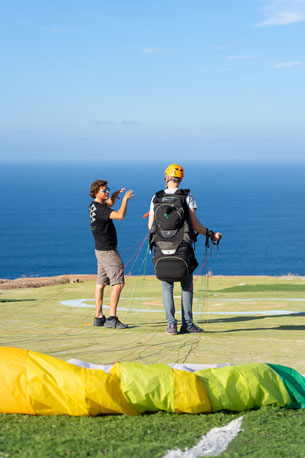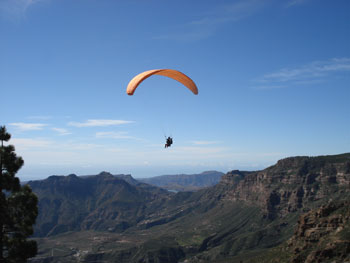Paragliding is one of the most exhilarating outdoor activities, offering a unique perspective of the world from high above. In places like Gran Canaria, where the landscapes are as diverse as they are breathtaking, paragliding offers an experience unlike any other. However, as with any adventure sport, safety is paramount. Whether you’re considering a solo flight or a tandem flight, understanding the essentials of paragliding safety in Gran Canaria is crucial to ensure a secure and enjoyable experience.

The Allure of Paragliding in Gran Canaria
Gran Canaria is a prime destination for paragliding enthusiasts. The island’s varied topography, combined with its favorable climate, makes it an ideal location for pilots. Gran Canaria offers a multitude of launching sites that cater to different skill levels. However, the island’s diverse environment also presents unique challenges that make understanding and prioritizing safety all the more important.
Understanding the Basics of Paragliding Safety
Before diving into the specifics of paragliding in Gran Canaria, it’s essential to understand the general principles of paragliding safety. Whether you’re flying solo or in tandem, the following safety measures are universally applicable:
- Pre-Flight Check: Always conduct a thorough pre-flight check of your equipment. This includes inspecting the wing, harness, lines, and reserve parachute. Ensure that everything is in good condition and that there are no signs of wear and tear. Radio communication is also necessary
- Weather Conditions: One of the most critical factors in paragliding safety is the weather. Always check the weather forecast before a flight. Ideal paragliding conditions include mild winds and clear skies. Avoid flying in strong winds, rain, or thunderstorms.
- Training and Certification: Ensure that you have the necessary training and certification to fly. For solo pilots, completing a certified training course is essential. For tandem flights, make sure that your pilot is licensed and has extensive experience.
- Understanding the Site: Every paragliding site is different. Familiarize yourself with the site’s specific conditions, including the terrain, wind patterns, and potential hazards. Local knowledge is invaluable in ensuring a safe flight.
Paragliding Safety in Gran Canaria: What Makes It Unique?
Gran Canaria’s unique landscape requires specific considerations when it comes to paragliding safety. Here are some of the factors that make paragliding safety in Gran Canaria distinct:
1. Diverse Terrain
Gran Canaria’s terrain ranges from high mountain peaks to rolling hills and coastal cliffs. Each type of terrain presents its own challenges. For instance, flying from a mountain launch site requires an understanding of thermal winds, which can be unpredictable. Coastal launches, on the other hand, may involve dealing with stronger winds and potential turbulence.
2. Microclimates
The island’s microclimates can change rapidly. It’s not uncommon to experience varying weather conditions within a short distance. This makes it crucial to stay informed about the local weather and to be prepared for sudden changes. When paragliding in Gran Canaria, always consult with local experts who can provide insights into the current conditions and any potential changes.
3. Popular Paragliding Sites
Gran Canaria has several popular paragliding sites, each with its own safety considerations:
- Los Giles: Located near Las Palmas, this site is popular for its accessibility and stunning views of the city and the ocean. However, the proximity to urban areas means that pilots need to be cautious about their landing zones.
- Fataga: Known for its reliable thermals, Fataga is a favorite among experienced pilots. The mountainous terrain requires a solid understanding of thermal flying and the ability to navigate potential turbulence.
- Artenara: This site offers some of the most spectacular views on the island, but its high altitude and rugged terrain mean that only experienced pilots should attempt to fly here.
Tandem Paragliding Safety in Gran Canaria
Tandem paragliding is an excellent option for those who want to experience the thrill of flight without the need for extensive training. In a tandem flight, a certified instructor controls the paraglider while the passenger enjoys the ride. Here’s what you need to know about tandem paragliding safety in Gran Canaria:
1. Choosing the Right Operator
Your safety in a tandem flight heavily depends on the experience and expertise of your instructor. When selecting a tandem paragliding operator in Gran Canaria, look for one with a strong reputation and positive reviews. Ensure that the operator has all the necessary certifications and that their equipment is regularly inspected and maintained.
2. Pre-Flight Briefing
Before your flight, the instructor should provide a thorough briefing. This will include instructions on takeoff and landing, how to sit comfortably in the harness, and what to do in case of an emergency. Don’t hesitate to ask questions if anything is unclear.
3. Equipment
For tandem flights, the equipment used is slightly different from that of solo flights. The tandem paraglider is designed to carry more weight, and the harnesses are built for comfort and safety. Ensure that your harness fits well and that all buckles and straps are securely fastened before takeoff.
4. Landing Safety
The landing is often the most challenging part of a tandem flight. Your instructor will guide you through the process, but it’s important to follow their instructions closely. Keep your legs raised during the landing approach and be ready to stand up quickly as you touch down.
Solo Paragliding Safety in Gran Canaria
For those who have undergone training and wish to fly solo, Gran Canaria offers a rewarding experience. However, solo paragliding requires a higher level of skill and understanding of safety protocols. Here’s what you need to consider:
1. Self-Assessment
Before embarking on a solo flight, honestly assess your skills and experience level. Gran Canaria’s varied flying conditions can be challenging, even for seasoned pilots. If you’re new to solo flying, consider hiring a local guide or taking an additional course to familiarize yourself with the island’s conditions.
2. Equipment Responsibility
As a solo pilot, you are fully responsible for your equipment. Regularly inspect your gear, including the wing, harness, reserve parachute, and helmet. Any signs of wear or damage should be addressed immediately. It’s also wise to carry a basic repair kit with you.
3. Flight Planning
Plan your flight carefully, taking into account the weather, terrain, and your own experience level. Avoid flying in unfamiliar conditions, and always have an alternative landing site in mind. Gran Canaria’s varied landscape means that some areas may be less suitable for landing than others.
4. Emergency Preparedness
Even with the best planning, emergencies can happen. Make sure you know how to deploy your reserve parachute and that it is in good condition. Familiarize yourself with emergency landing procedures and be aware of the locations of local hospitals and rescue services.
The Role of Local Knowledge in Paragliding Safety
One of the most significant advantages of paragliding in Gran Canaria is the availability of local experts who know the island’s conditions inside and out. Whether you’re a solo pilot or planning a tandem flight, tapping into this local knowledge is invaluable. Local instructors and guides can provide real-time updates on weather conditions, recommend the best launch sites for your skill level, and offer tips on how to navigate the island’s unique flying conditions.
Conclusion: Enjoying Paragliding in Gran Canaria Safely
Paragliding in Gran Canaria is an unforgettable experience, offering a bird’s-eye view of one of the most beautiful islands in the world. However, the key to making the most of this adventure lies in prioritizing safety. Whether you’re flying solo or tandem, understanding the specific challenges of Gran Canaria’s terrain and weather, ensuring your equipment is in top condition, and being prepared for any eventuality are all crucial components of a safe flight.
By following these guidelines and respecting the principles of paragliding safety in Gran Canaria, you can enjoy the thrill of flight while minimizing risks, ensuring that your paragliding adventure is as safe as it is exhilarating.

